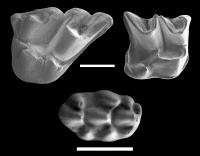
Holotypes from the new species discovered in this research: first superior molar of the Archaeodesmana elvirae, Blarinoides aliciae and Micromys caesaris. The scale is equivalent to 1 mm. How did the rodents which inhabited the south of the Iberian Peninsula live six million years ago" The researcher of the UGR Raef Minwer-Barakat has attempted to answer this question through his doctoral thesis "Rodents and insectivorous of Upper Turoliense and the Pliocene of the central section of the Guadix basin", supervised by doctors Elvira Martín and César Viseras, of the Dept. of Stratigraphy and Palaeontology of the University of Granada. His studied has concluded with the discovering of three new species of rodents and insectivores (Micromys caesaris, Blarinoides aliciae and Archaeodesmana elvirae) and the finding, for the first time in the region, of nine more species.
Minwer-Barakat chose the Guadix basin to develop his study due to the excellent conditions of the area and its abundance of fossils of small mammals. Although there were previous studied on rodents in this region, no-one had had carried out such a complete study were on the fauna of fossil insectivores.
This research work is based on the analysis of the dental structures of rodents, key elements in Palaeontology to differentiate between two species as they become fossilized very easily.
The research work, backed by the UGR, has also managed to determine that the Myocricetodon jaegeri, a species of gerbil whose presence has been documented at the end of the Miocene from Africa, a theory which had not been confirmed yet.
The climate
Raef Minwer-Barakat´s thesis has allowed to carry out a radiography of the climate evolution in the south of the Iberian Peninsula in the analyzed periods. In the Upper Turoliense (from 6 to 5.3 million years ago) the climate was almost desert-like, with scarce vegetation, and during the Rusciniense and at the beginning of the Villafranquiense (from 5.3 to 3 million years ago) the conditions became warmer and damper. At the end of the lower Villafranquiense and during the middle Villafranquiense Granada’s climate became much colder and drier, with a predominance of open herbaceous environments.
Source : Universidad de Granada
 Print Article
Print Article Mail to a Friend
Mail to a Friend
